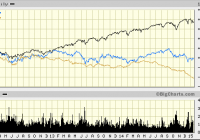China Grabs A Bigger Share Of The Indexes
Traditional international index funds assign a weight to each country based on the size of its stock market. But in the case of China, that’s a bit misleading. Despite having the world’s second-largest economy, China has a relatively small number of publicly traded companies. Moreover, many of those publicly traded companies have been off-limits to foreign investors. As a result, the Vanguard Total World Stock ETF (NYSEARCA: VT ) allocates just 2.5% to China—considerably less that than the share allotted to much smaller economies such as Canada, Switzerland and France. This is about to change: during the coming months and years, index investors will be able to access more of China’s vast economy. Vanguard recently announced that its flagship emerging markets ETF, the Vanguard FTSE Emerging Markets (NYSEARCA: VWO ), will soon be adding China A-shares to its benchmark index. This development will also affect Canadian-listed ETFs that include this fund as an underlying holding. Taking the A-train Let’s look at what this means for indexers. Right now, most foreign investors can buy public companies in mainland China only through share classes denominated in foreign currency and traded on exchanges outside the country, particularly in Hong Kong and the US. These are the shares included in the emerging markets funds that North Americans own today. A-shares, by contrast, are denominated in renminbi and are listed on China’s national stock exchanges in Shanghai and Shenzhen. They are generally available only to Chinese nationals and a small number of highly regulated foreign institutional investors. But this regime is changing as China begins to loosen its control over foreign investment. That has prompted index providers to consider adding A-shares to their popular emerging markets indexes. FTSE (the index provider for many Vanguard funds) has already done so , and MSCI (whose indexes are tracked by iShares and BMO funds) seems likely to do so this year. As the index changes unfold, ETFs tracking these benchmarks will be compelled to add Chinese A-shares as well. The upshot is that China will get an increasingly large share of cap-weighted indexes. It won’t happen overnight: Morningstar estimates the changes will bump up China’s allocation in the FTSE Emerging Markets Index by a modest three percentage points in the near term, from about 29% to 32%. But over time it seems likely that share will grow considerably as additional A-shares become available to foreign investors. This evolution will affect the Canadian-listed Vanguard FTSE Emerging Markets (VEE) , since this fund uses VWO as its underlying holding. It will also have a modest effect on the Vanguard FTSE All-World ex Canada (VXC) , which gets its emerging markets exposure from VWO . It seems likely that emerging markets index funds from other providers will also see similar changes in the future, including the iShares MSCI Emerging Markets (XEM) and BMO MSCI Emerging Markets (ZEM) , which both track the same benchmark. What’s it all mean? So what’s the takeaway message for Couch Potato investors who have some emerging markets in their portfolios? At this point, it’s hard to know what effect the addition of Chinese A-shares will have, but it’s likely to be very small. It should not prompt you to make any changes in your portfolio. Let’s remember that the allocation to Chinese A-shares in a balanced portfolio will be trivially small—Vanguard estimates they will make up 0.55% of VXC , which itself is less than half of a balanced ETF portfolio. Taking a longer view, passive investors should generally applaud any index changes that better represent the global markets. As Forbes puts it, including China’s A-shares in widely used emerging markets indexes is “acknowledging that the Chinese mainland stock market has matured and is ready for serious, long term investors.”
